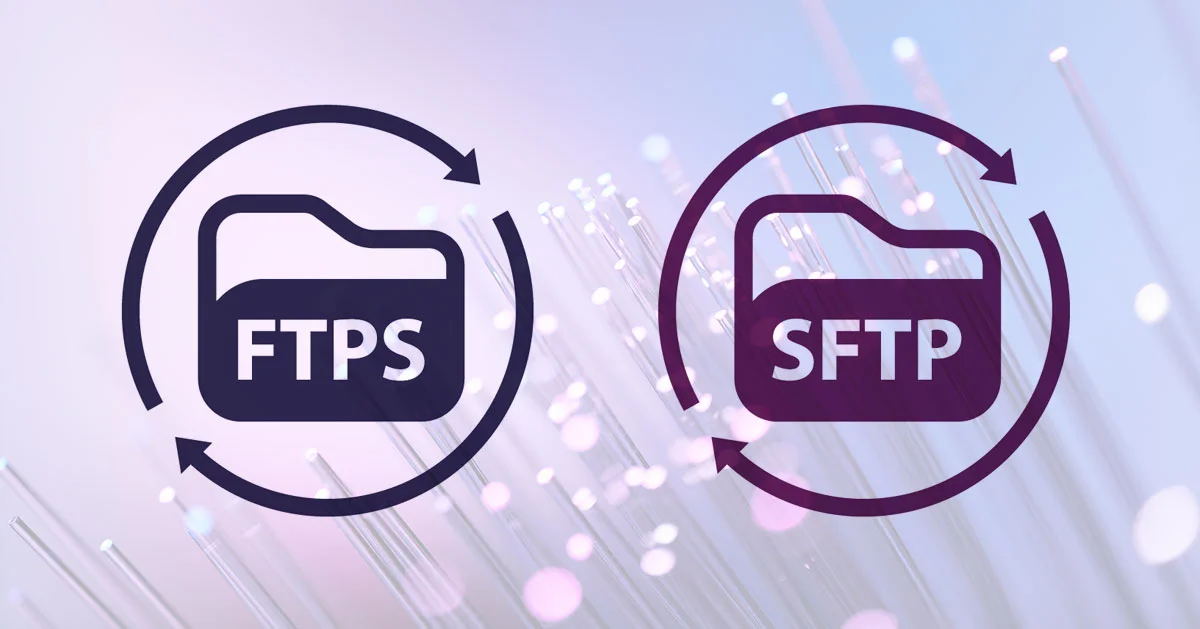FTP with SSL/TLS vs. SFTP: which offers better security?
10th September 2025
When it comes to secure file transfer, two methods in particular often crop up. These are FTP with SSL/TLS (also known as File Transfer Protocol Secure, or FTPS) and SFTP (Secure File Transfer Protocol). Although both offer encryption, the ways in which they do so differ, as does their suitability for specific uses.
Organisations looking to modernise their file transfer processes commonly find themselves choosing between these two options. Legacy systems might favour one, while newer and more security-conscious deployments may lean towards the other. Understanding their differences is the key to finding the right fit.
In this blog, we’ll look in more detail at the technical distinctions, security differences and practical considerations of both FTP with SSL/TLS and SFTP. This should help you to decide just which of them is best suited to the particular needs of your business.

What is FTP with SSL/TLS (FTPS)?
FTP with SSL/TLS, or SFTP, is essentially the traditional File Transfer Protocol (FTP) enhanced with an encryption layer. It uses Secure Sockets Layer (SSL), or its successor Transport Layer Security (TLS), to secure the communication, thereby protecting data in transit from eavesdropping or tampering.
FTP operates over two channels: a command channel (for sending instructions) and a data channel (for sending files) usually conducted over a “Passive Mode” (PASV) port – future blog article to come. Both channels can be encrypted depending on the server and client settings. This two-channel setup means FTPS often uses multiple ports, which can be trickier to configure through firewalls.
For organisations with older systems or established FTP workflows, FTPS can be an attractive option because it maintains compatibility with existing infrastructure while adding modern encryption for security purposes.
What is SFTP?
Although SFTP (Secure File Transfer Protocol) has a very similar name to FTPS (File Transfer Protocol, or FTP Secure), it’s entirely different. SFTP operates as a subsystem of the Secure Shell (SSH) protocol, which is widely used for secure remote administration.
Unlike FTPS, SFTP runs over a single port (usually port 22), which makes it simpler to set up and more firewall friendly. It encrypts both commands and data in a single channel, reducing configuration complexity while simultaneously enhancing security.
SFTP’s flexible authentication methods are another of its strengths. It supports username and password login as well as private/public key authentication, which can remove the need for passwords entirely (or in addition to) when integrating with automated systems. This adds an extra layer of security and reduces the risk of credentials being compromised.
Security considerations
Both FTPS and SFTP provide strong encryption, but they do so in different ways:
Encryption standards: FTPS relies on SSL/TLS encryption, which is robust and supported but requires careful management of certificates. SFTP uses SSH-based encryption, which is equally secure and often easier to configure.
Authentication: FTPS typically uses username/password certificates with optional client certificates. SFTP’s option for public key authentication allows passwordless, highly secure system-to-system transfers.
Firewall configuration: FTPS’s multi-port nature can complicate firewall rules, potentially creating vulnerabilities if not handled correctly. SFTP’s single-port approach is simpler and less prone to misconfiguration.
Performance and compatibility
From a performance perspective, both protocols can handle large file transfers efficiently, but SFTP’s single-channel design can reduce latency in some scenarios. FTPS shines in legacy compatibility, so if your systems already use FTP and you have an established certificate management process, upgrading to FTPS can be a relatively smooth transition without needing new infrastructure.
SFTP, however, is often the better option for modern applications and cloud integrations, where firewall traversal, automation and key-based authentication are priorities.
Which should you choose?
Whether you choose FTPS or SFTP will likely depend on your current infrastructure and security requirements. Bear these general rules in mind:
Choose FTPS (FTP with SSL/TLS) if you need compatibility with older systems, already use FTP extensively or have a well-managed certificate environment.
Choose SFTP if you want a simpler setup with more flexible authentication, fewer firewall headaches and better potential for automation.
In many cases, businesses moving towards modern, automated workflows prefer SFTP for its simplicity and robust security model. Even so, FTPS remains a viable and secure option for specific use cases.
Conclusion
Both FTP with SSL/TLS (FTPS) and SFTP are secure file transfer protocols, but their strengths lie in different areas. FTPS offers a familiar, certificate-based approach ideal for legacy systems, while SFTP provides streamlined configuration and advanced authentication options for more modern deployments.
When deciding which protocol is better suited to your needs, weigh up your security priorities, existing infrastructure and likely future needs – but if SFTP is available, use it to future-proof your integrations. Whichever one you choose, strong encryption, secure authentication and good all-round security practices will all be vital to protecting your data in transit.

We can help you
Ridgeon Network’s SFTP hosting service provides rock-solid security and first-class support from our expert team. Our service supports both FTPS and FTPS, as well as a full web-based interface.
Get in touch with us today to discuss what we can do to help your business.